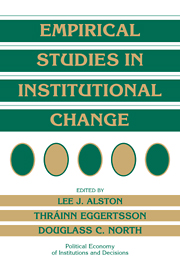Book contents
- Frontmatter
- Contents
- List of contributors
- Series editors' preface
- Acknowledgments
- Introduction
- A note on the economics of institutions
- Empirical work in institutional economics: an overview
- 1 Toward an understanding of property rights
- Economic variables and the development of the law: the case of western mineral rights
- 2 Impediments to institutional change in the former Soviet system
- Why economic reforms fail in the Soviet system: a property rights–based approach
- 3 Transaction costs and economic development
- Public institutions and private transactions: a comparative analysis of the legal and regulatory environment for business transactions in Brazil and Chile
- 4 The evolution of modern institutions of growth
- Constitutions and commitment: the evolution of institutions governing public choice in seventeenth-century England
- 5 Regulation in a dynamic setting
- The political economy of controls: American sugar
- 6 Price controls, property rights, and institutional change
- Roofs or stars: the stated intents and actual effects of a rents ordinance
- 7 Regulating natural resources: the evolution of perverse property rights
- Legally induced technical regress in the Washington salmon fishery
- 8 The politics of institutional change in a representative democracy
- A political theory of the origin of property rights: airport slots
- 9 The economics and politics of institutional change
- Paternalism in agricultural labor contracts in the U.S. South: implications for the growth of the welfare state
- Epilogue: economic performance through time
- Author index
- Subject index
- POLITICAL ECONOMY OF INSTITUTIONS AND DECISIONS
The political economy of controls: American sugar
Published online by Cambridge University Press: 05 June 2012
- Frontmatter
- Contents
- List of contributors
- Series editors' preface
- Acknowledgments
- Introduction
- A note on the economics of institutions
- Empirical work in institutional economics: an overview
- 1 Toward an understanding of property rights
- Economic variables and the development of the law: the case of western mineral rights
- 2 Impediments to institutional change in the former Soviet system
- Why economic reforms fail in the Soviet system: a property rights–based approach
- 3 Transaction costs and economic development
- Public institutions and private transactions: a comparative analysis of the legal and regulatory environment for business transactions in Brazil and Chile
- 4 The evolution of modern institutions of growth
- Constitutions and commitment: the evolution of institutions governing public choice in seventeenth-century England
- 5 Regulation in a dynamic setting
- The political economy of controls: American sugar
- 6 Price controls, property rights, and institutional change
- Roofs or stars: the stated intents and actual effects of a rents ordinance
- 7 Regulating natural resources: the evolution of perverse property rights
- Legally induced technical regress in the Washington salmon fishery
- 8 The politics of institutional change in a representative democracy
- A political theory of the origin of property rights: airport slots
- 9 The economics and politics of institutional change
- Paternalism in agricultural labor contracts in the U.S. South: implications for the growth of the welfare state
- Epilogue: economic performance through time
- Author index
- Subject index
- POLITICAL ECONOMY OF INSTITUTIONS AND DECISIONS
Summary
In economic theory, it is relatively straightforward to analyse the impact of government controls over economic activity. Whether the control is over feed-grain prices in Egypt, the quantities of imports of individual items in India, price controls on ‘old’ oil, or the ‘voluntary’ reduction in the number of automobiles exported from Japan to the United States, several conclusions follow straightforwardly. First and foremost, those controls (and most others) at best achieve their objectives in a more costly manner than would alternative mechanisms. Second, the presumed beneficiaries of controls are often quite different from those (if any) actually benefiting. Third, the costs of controls seem to be largely ignored or misunderstood in political decision-making, at least in the first instance.
Despite these well-established results, controls seem to persist. A major challenge confronting those concerned with their costs is to attempt to understand the reasons why the political process often generates and perpetuates high-cost solutions to stated objectives. To establish an understanding of the political economy of controls would appear to be a formidable, but important, challenge, if means are to be sought to lower the costs of attaining political objectives.
The purpose of this chapter is to attempt to further our understanding of the political economy of controls. Section i provides a survey of existing models of regulation. The remainder of the chapter is then devoted to an examination of how well those models perform in light of the history of one particular set of controls – the American sugar programme.
- Type
- Chapter
- Information
- Empirical Studies in Institutional Change , pp. 169 - 218Publisher: Cambridge University PressPrint publication year: 1996
- 8
- Cited by



